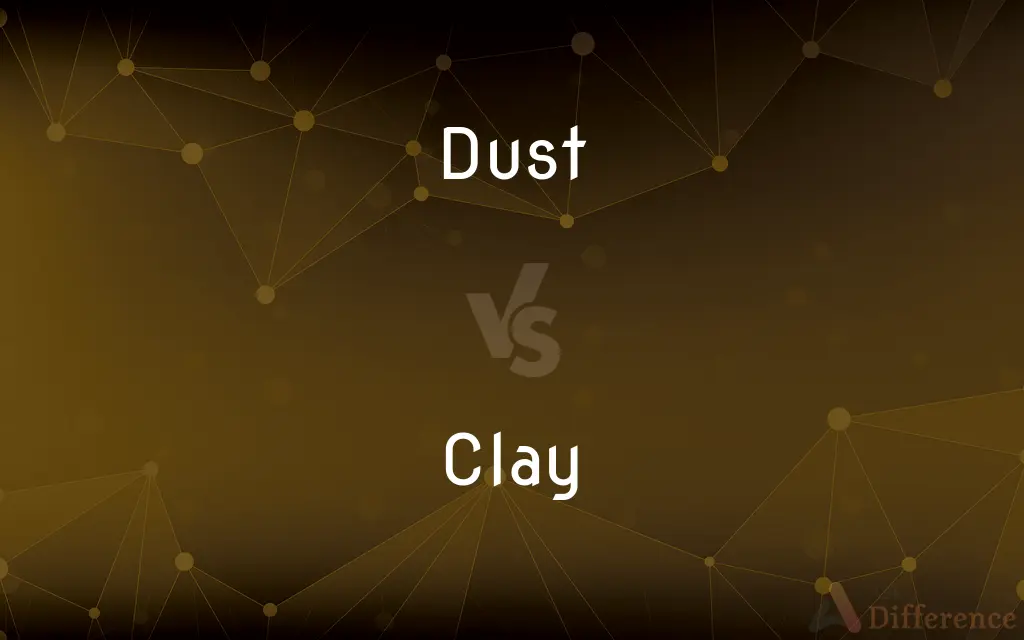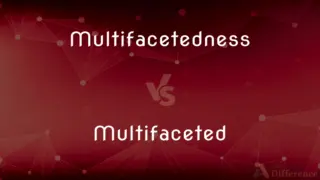Dust vs. Clay — What's the Difference?
By Tayyaba Rehman & Urooj Arif — Updated on March 28, 2024
Dust is fine, dry particles in the air or on surfaces, while clay is a moist, earthy material used in ceramics and construction.

Difference Between Dust and Clay
Table of Contents
ADVERTISEMENT
Key Differences
Dust comprises tiny particles of matter that can originate from various sources, including soil, pollen, skin cells, and industrial activities. These particles are small enough to be suspended in the air and settle on surfaces. Clay, on the other hand, is a natural, earthy material composed of fine-grained minerals, primarily distinguished by its plasticity when wet and its ability to harden when dried or fired, making it essential in pottery, sculpture, and construction.
While dust can be considered a nuisance or an allergen, posing health risks when inhaled, clay is valued for its wide range of uses from artistic expressions in ceramics to practical applications in brick and tile manufacturing. Dust particles are often the result of wear and degradation of larger materials, contributing to indoor air pollution and requiring regular cleaning to manage. Clay, conversely, is harvested from the earth, processed, and often mixed with other substances to enhance its properties for specific applications such as pottery, construction, and even in health and beauty products.
The composition of dust can vary greatly depending on the environment, including both organic and inorganic components, making it a complex mixture that can affect air quality and health. Clay's composition is more consistent, primarily made up of silicate minerals with varying amounts of water trapped in the mineral structure, giving it unique characteristics such as plasticity and the ability to be molded and shaped.
Dust is a ubiquitous presence in both indoor and outdoor environments, affecting everything from air quality to electronics functionality, and requires continual efforts to minimize its accumulation. Clay, while also found widely in the natural environment, is specifically sought after for its beneficial properties, extracted from the earth, and often refined for various uses in industries ranging from construction to arts and crafts.
Dust and clay are distinct materials with different origins, compositions, and implications for human health and activity. Dust, a byproduct of environmental and human-made processes, is often associated with cleanliness and health issues, while clay is actively sought for its utility in crafting, construction, and other specialized applications.
ADVERTISEMENT
Comparison Chart
Composition
Varied, including soil, pollen, skin cells.
Fine-grained minerals, primarily silicates.
Consistency
Dry, fine particles.
Moist, earthy, plastic when wet.
Uses
Considered a nuisance, requires cleaning.
Used in ceramics, construction, beauty products.
Health Impact
Can be an allergen or contribute to air pollution.
Generally safe, but inhalation of dry particles can be harmful.
Properties
Can be airborne, settles on surfaces.
Malleable when wet, hardens when dried or fired.
Compare with Definitions
Dust
Fine Particles in Air or on Surfaces.
The morning sunlight revealed the dust floating in the air.
Clay
Earthy Material for Ceramics.
The artist molded the clay into a beautiful vase.
Dust
Result of Material Breakdown.
Dust accumulated on the old books over the decades.
Clay
Plasticity When Wet.
The wet clay was easily shaped on the potter's wheel.
Dust
Cleaning Challenge in Homes.
She spent the afternoon dusting the shelves and furniture.
Clay
Construction Material.
Bricks made from clay were used to build the house.
Dust
Potential Allergen.
Dust mites in household dust can trigger allergic reactions.
Clay
Hardens When Dried or Fired.
The clay sculptures were fired in a kiln to make them hard and durable.
Dust
Symbol of Neglect or Disuse.
The abandoned car was covered in a thick layer of dust.
Clay
Natural, Fine-Grained Soil.
They found deposits of high-quality clay near the riverbank.
Dust
Dust is made of fine particles of solid matter. On Earth, it generally consists of particles in the atmosphere that come from various sources such as soil lifted by wind (an aeolian process), volcanic eruptions, and pollution.
Clay
Clay is a type of fine-grained natural soil material containing clay minerals. Clays develop plasticity when wet, due to a molecular film of water surrounding the clay particles, but become hard, brittle and non–plastic upon drying or firing.
Dust
Fine, dry particles of matter.
Clay
A stiff, sticky fine-grained earth that can be moulded when wet, and is dried and baked to make bricks, pottery, and ceramics
A clay soil
A clay tile
The soil is mainly clay
The rocks are covered by various mixtures of loose clays and sands
Dust
A cloud of fine, dry particles.
Clay
A European moth with yellowish-brown wings.
Dust
Particles of matter regarded as the result of disintegration
Fabric that had fallen to dust over the centuries.
Clay
A fine-grained, firm earthy material that is plastic when wet and hardens when heated, consisting primarily of hydrated silicates of aluminum and widely used in making bricks, tiles, and pottery.
Dust
Earth, especially when regarded as the substance of the grave
"ashes to ashes, dust to dust" (Book of Common Prayer).
Clay
A hardening or nonhardening material having a consistency similar to clay and used for modeling.
Dust
The surface of the ground.
Clay
(Geology) A sedimentary material with grains smaller than 0.002 millimeter in diameter.
Dust
A debased or despised condition.
Clay
Moist sticky earth; mud.
Dust
Something of no worth.
Clay
The human body as opposed to the spirit.
Dust
Chiefly British Rubbish readied for disposal.
Clay
A mineral substance made up of small crystals of silica and alumina, that is ductile when moist; the material of pre-fired ceramics.
Dust
Confusion; agitation; commotion
Won't go back in until the dust settles.
Clay
An earth material with ductile qualities.
Dust
To remove dust from by wiping, brushing, or beating
Dust the furniture.
Clay
(tennis) A tennis court surface made of crushed stone, brick, shale, or other unbound mineral aggregate.
The French Open is played on clay.
Dust
To sprinkle with a powdery substance
Dusted the cookies with sugar.
Dust crops with fertilizer.
Clay
(biblical) The material of the human body.
Dust
To apply or strew in fine particles
Dusted talcum powder on my feet.
Clay
(geology) A particle less than 3.9 microns in diameter, following the Wentworth scale.
Dust
(Baseball) To deliver a pitch so close to (the batter) as to make the batter back away.
Clay
A clay pipe for smoking tobacco.
Dust
To clean by removing dust.
Clay
A clay pigeon.
We went shooting clays at the weekend.
Dust
To cover itself with dry soil or other particulate matter. Used of a bird.
Clay
(informal) Land or territory of a country or other political region, especially when subject to territorial claims
Danzig is rightfully German clay.
Dust
Fine particles
Clay
(transitive) To add clay to, to spread clay onto.
Dust
(uncountable) Fine, dry particles of matter found in the air and covering the surface of objects, typically consisting of soil lifted up by the wind, pollen, hair, etc.
Clay
To purify using clay.
Dust
Submicron particles in outer space, largely silicates and carbon compounds, that contribute greatly to extinction at visible wavelengths.
Clay
A soft earth, which is plastic, or may be molded with the hands, consisting of hydrous silicate of aluminium. It is the result of the wearing down and decomposition, in part, of rocks containing aluminous minerals, as granite. Lime, magnesia, oxide of iron, and other ingredients, are often present as impurities.
Dust
(obsolete) A single particle of earth or other material.
Clay
Earth in general, as representing the elementary particles of the human body; hence, the human body as formed from such particles.
I also am formed out of the clay.
The earth is covered thick with other clay,Which her own clay shall cover.
Dust
(countable) The act of cleaning by dusting.
Clay
To cover or manure with clay.
Dust
The earthy remains of bodies once alive; the remains of the human body.
Clay
To clarify by filtering through clay, as sugar.
Dust
(figurative) Something worthless.
Clay
A very fine-grained soil that is plastic when moist but hard when fired
Dust
(figurative) A low or mean condition.
Clay
Water soaked soil; soft wet earth
Dust
Cash; money (in reference to gold dust).
Clay
United States general who commanded United States forces in Europe from 1945 to 1949 and who oversaw the Berlin airlift (1897-1978)
Dust
(colloquial) A disturbance or uproar.
To raise, or kick up, a dust
Clay
United States politician responsible for the Missouri Compromise between free and slave states (1777-1852)
Dust
(mathematics) A totally disconnected set of points with a fractal structure.
Dust
(transitive) To remove dust from.
The cleaning lady needs a stool to dust the cupboard.
Dust
(intransitive) To remove dust; to clean by removing dust.
Dusting always makes me cough.
Dust
(intransitive) Of a bird, to cover itself in sand or dry, dusty earth.
Dust
(transitive) To spray or cover something with fine powder or liquid.
The mother dusted her baby's bum with talcum powder.
Dust
To leave; to rush off.
Dust
To reduce to a fine powder; to levigate.
Dust
Fine, dry particles of earth or other matter, so comminuted that they may be raised and wafted by the wind; that which is crumbled to minute portions; fine powder; as, clouds of dust; bone dust.
Dust thou art, and unto dust shalt thou return.
Stop! - for thy tread is on an empire's dust.
Dust
A single particle of earth or other matter.
Dust
The earthy remains of bodies once alive; the remains of the human body.
And you may carve a shrine about my dust.
Dust
Figuratively, a worthless thing.
And by the merit of vile gold, dross, dust.
Dust
Figuratively, a low or mean condition.
[God] raiseth up the poor out of the dust.
Dust
Gold dust
Dust
To free from dust; to brush, wipe, or sweep away dust from; as, to dust a table or a floor.
Dust
To sprinkle with dust.
Dust
To reduce to a fine powder; to levigate.
Dust
Fine powdery material such as dry earth or pollen that can be blown about in the air;
The furniture was covered with dust
Dust
The remains of something that has been destroyed or broken up
Dust
Free microscopic particles of solid material;
Astronomers say that the empty space between planets actually contains measurable amounts of dust
Dust
Remove the dust from;
Dust the cabinets
Dust
Rub the dust over a surface so as to blur the outlines of a shape;
The artist dusted the charcoal drawing down to a faint image
Dust
Cover with a light dusting of a substance;
Dust the bread with flour
Dust
Distribute loosely;
He scattered gun powder under the wagon
Common Curiosities
What makes clay special in pottery?
Clay's plasticity when wet allows it to be shaped into various forms, which then harden upon drying or firing, making it ideal for pottery.
What exactly is dust made of?
Dust is composed of tiny particles from various sources, including soil, pollen, skin cells, and fabric fibers.
Can dust be harmful to health?
Yes, dust can be harmful, especially fine dust that can be inhaled, leading to respiratory issues and allergic reactions.
Are there different types of clay?
Yes, there are several types of clay, including kaolin, bentonite, and ball clay, each with unique properties suitable for different uses.
Can dust damage electronics?
Yes, dust can clog and overheat electronic components, reducing their efficiency and lifespan.
What precautions should be taken when working with clay?
Wearing a mask when handling dry clay can prevent inhalation of fine particles, and using gloves can protect skin from drying out.
What role does clay play in art?
Clay is a fundamental material in art, especially in sculpture and pottery, allowing artists to express creativity through three-dimensional forms.
How is clay used in construction?
Clay is used in construction to make bricks, tiles, and other building materials, valued for its durability and natural insulation properties.
How can dust accumulation be minimized?
Regular cleaning, using air purifiers, and maintaining humidity levels can help minimize dust accumulation in homes.
How is clay sourced?
Clay is extracted from the earth, often from deposits near rivers, where fine particles have accumulated over time.
What are the environmental impacts of dust?
Dust can affect air quality, reduce visibility, and impact ecosystems when it settles on water and land.
Can clay be used for water purification?
Certain types of clay can absorb impurities and are used in water purification processes.
How do dust storms form?
Dust storms occur when high winds lift large amounts of dust from dry soils into the air, often in arid and semi-arid regions.
How does dust affect indoor air quality?
Dust contributes to poorer indoor air quality by carrying allergens and microorganisms that can be harmful to health.
Is clay recyclable?
Yes, unfired clay can be recycled by rehydrating it to its plastic state for reuse.
Share Your Discovery

Previous Comparison
Cricket vs. Soccer
Next Comparison
Multifacetedness vs. MultifacetedAuthor Spotlight
Written by
Tayyaba RehmanTayyaba Rehman is a distinguished writer, currently serving as a primary contributor to askdifference.com. As a researcher in semantics and etymology, Tayyaba's passion for the complexity of languages and their distinctions has found a perfect home on the platform. Tayyaba delves into the intricacies of language, distinguishing between commonly confused words and phrases, thereby providing clarity for readers worldwide.
Co-written by
Urooj ArifUrooj is a skilled content writer at Ask Difference, known for her exceptional ability to simplify complex topics into engaging and informative content. With a passion for research and a flair for clear, concise writing, she consistently delivers articles that resonate with our diverse audience.















































